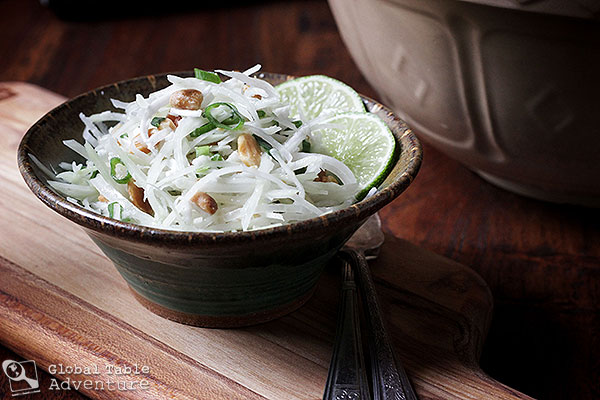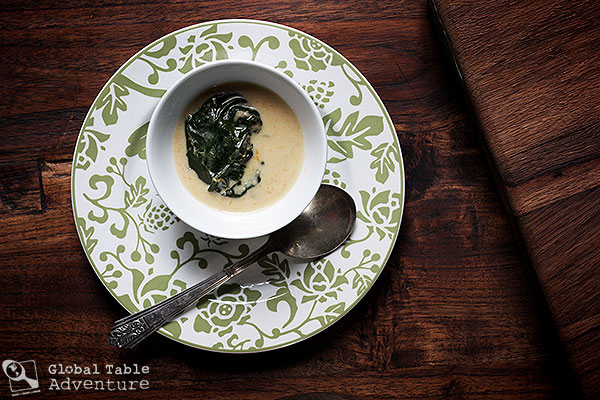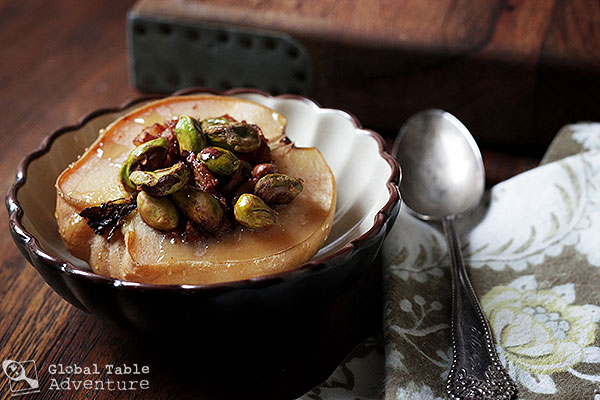Last week someone asked me if I was going to cook with rocks because that’s how they cook in Vanuatu. It was a fair question and one that, about two years ago, would have gotten me all sweaty and stressed out. I would have asked myself if I was treating the people of Vanuatu fairly by not digging a pit in my back yard, scavenging large rocks from local hiking trails, then cooking the meal beneath our Oklahoma red dirt. But now, three years and seven months into this Adventure, my answer comes without any regret. No. Over the last years, this blog has helped me figure out who I am and what I am capable of. Right now, I have at my disposition a standard stove/oven combo. When the kitchen gets too hot, I have an old gas grill in the back yard. Once in a while we use my chimnea to roast marshmallows. In Vanuatu, you work with what you have. You celebrate what you have. And that’s no different here, in my little corner of middle …
Read More
What do you do when you’re running low on inspiration? Do you sip a cup of tea, take a walk, paint, write a poem, cook something? Or do you freeze up, unable to create? Writing a book for the last several months has had an interesting effect on my brain-space. The book is incredibly daunting and takes all my creative juices. I find myself sopping through my house like a wrung out rag. I once read that we are only capable of making a certain number of decisions each day. After that time, we’re pretty much worthless. Sometimes, after a particularly long book writing session, I can’t even decide what pajamas I want to curl up in to decompress. Thankfully, the world is a resource. It’s a constant inspiration. Remember, even on those nights you’re too tired to pop popcorn, the world is there, whispering sweet nothings to you. Inviting you to try something different. And so here we are… today, Vanuatu is doing the whispering. Since I spent yesterday grating a mountain range of …
Read More
It only takes five minutes of grating sweet potatoes to make me wax poetic on the brilliance of the food processor. Friends, I certainly don’t have biceps of steel. Most days, I don’t even see my biceps beneath the jiggle. Today’s recipe for Simboro gave them a work out. I first learned about Simboro from a reader named Benjamin who spent some time in Vanuatu. This comforting side dish is made with a grated starch, like cassava, sweet potato, or yam, wrapped in “island cabbage,” then simmered in coconut milk. As much as it pained my muscles… I treated the grating like a ritual – a rite of passage – a way to imagine myself in Vanuatu telling tourists “THIS way to the beach.” Thirty minutes later, only my pride had kept me from pulling out the food processor. Because, the fact of the matter is that the sweet potato could just as easily be run through the grater attachment on your food processor, then ground finer in the processor bowl to achieve similar results… leaving …
Read More

“A woman is like a stick you throw.” Proverb from Vanuatu On the surface, this proverb from Vanuatu does not exactly sound flattering. But it turns out it is. In fact, it’s a term of endearment. In Vanuatu, there’s a plant called nanggalat, which takes root and thrives wherever you throw it – even on the jagged edge of a cliff. Comparing a woman to a thrown stick – in Vanuatu – is saying she can adapt and thrive anywhere. (Source) It’s all about context. This week we’re making two recipes from Vanuatu to learn more about this culture. Enjoy and, when it’s all over, may we all be more like thrown sticks. Recipes and meal review will be posted throughout the week. Simboro [Recipe] Grated sweet potato wrapped in leaves, then boiled in coconut milk. These tidy little dumplings make a lovely side dish in the autumn. Green PawPaw Salad [Recipe] A tropical salad brought to you by Vanuatu’s most popular produce: shredded green papaya, coconut, green onion, and fresh lime juice. Done and done.
Read More
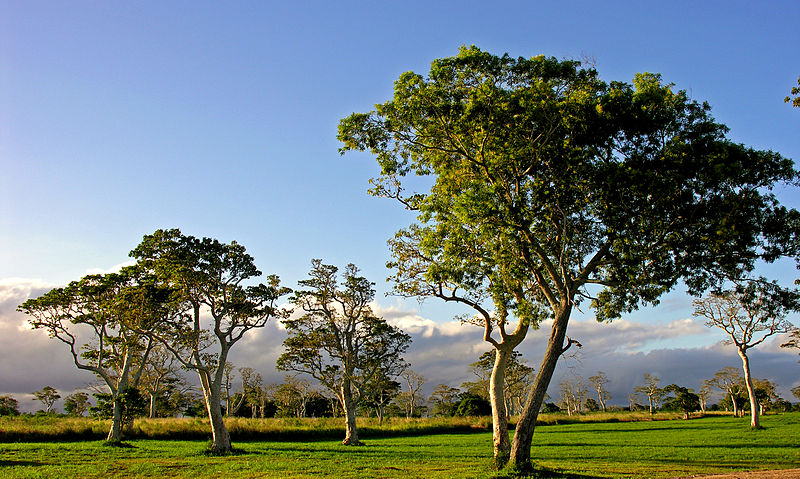
Those who live in glass houses shouldn’t throw stones. But what about those who live in wood, bamboo, and palm leaf houses? In the 80 islands that make up Vanuatu, the hot, humid weather makes for an entirely different living experience, one where – traditionally speaking – thatched roofs keep out the rain instead of tile. While stones aren’t exactly thrown, in Vanuatu they are heated and piled on top of food. This traditional method is typical of Oceania. Lap lap the most notable of dishes, made with either yam, cassava, plantain, or sweet potato that has been grated, wrapped in banana leaves (with coconut milk), then roasted under hot stones. Reader, Benjamin, who spent some time in Vanuatu, told me more about the dish, how they add chicken on top of the grated starch: …they take a couple of the hot rocks, each about the size of a baseball, rinse them of ashes and then place them in the center of the Laplap. During cooking this creates a well like crater in the center. They …
Read More
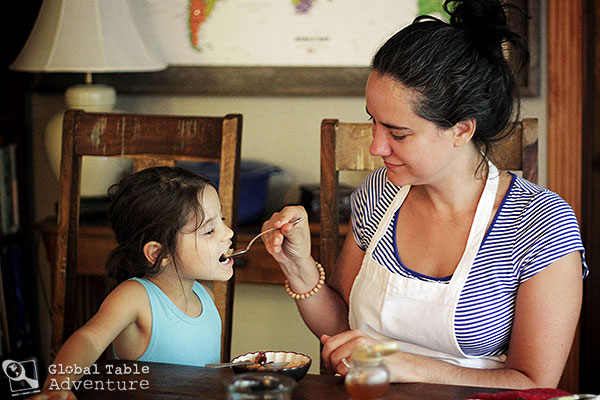
Stirring, stirring, stirring. Uzbekistan requires no stirring. Just a layering of this vegetable, then that… a stuffed quince and few chopped nuts. But no stirring. Definitely nothing of the sort. Have you ever noticed how hard it is to just wait? To wait and do nothing? To wait and trust that everything will come out okay, no burning, no overcooking, no drying out? How hard it is to not stir the pot? With just three weeks until our big event at Philbrook and two months until the end of our Global Table Adventure, this message feels particularly apropos. I feel like there should be something I should be doing. But sometimes we just need to wait, and savor the results when the time comes. THIS WEEK’s FOOD Harvest Stew | Dimlama [Recipe] What I loved most about this dish: The key to dimlama is browning the onion and meat, so it’s no coincidence that the resulting brown gravy is also my favorite part of the stew. The hint of cumin and cilantro gives the dish the characteristic Uzbek edge, making it …
Read More
Say “Quince” to an Uzbek lady, and you just might see her flush with delight. Though they aren’t eaten raw, baked quince are soft and tender, like a pear. The taste is mild, something like an apple, but with traces of pear, too. Uzbekistan is the third greatest producer of quince, after Turkey and China. They include the fruit in plov, stir it into preserves, and they bake it up with honey, and sometimes even stuff it nuts… as we’re doing today. How to choose a quince: – look for white fuzzies on the stem end, which indicate freshness – a ripe quince is yellow, although slightly green fruit can be used for this recipe – it can be bumpy and odd-shaped, but there should be no scarring or other markings. Serves 4-6 Ingredients: 2-3 quince (or 3 large apples) 1/2 cup pistachios 1/2 cup walnuts, chopped (or substitute more pistachios) 1/2 tsp cinnamon honey, to taste (1-2 Tbsp per person) For the baking dish: 1 cup water 2-3 slices lemon Method: Let’s go to …
Read More
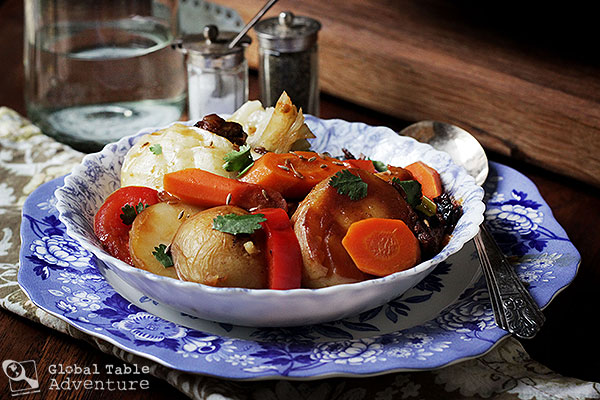
If it were up to me, every gardener would know about Dimlama, the Uzbek one-pot answer to harvest-time (no canning required). While every Uzbek family makes it a little differently, potatoes, carrots, peppers, and tomatoes are standard fare, as is a hearty sprinkling of whole cumin seeds. The key to dimlama rests in the layering. First of all, lamb is browned, then onions are added in the mix. One they submit to browning, the remaining vegetables are layered (and, once they’re added, you never stir the pot!). The final layer is always cabbage, which helps seal in the moisture. When the vegetables release their juices, they drip down to the bottom of the pan and deglaze all those nummy browned bits. The result? A luscious brown gravy worthy of being sopped up by a nice piece of Central Asian Yogurt Naan. Serves 6 Ingredients: 1/2-1 lb cubed lamb or beef 1 large onion, sliced in quarter moons 5 small yellow potatoes cut in half 2-3 large carrots, peeled & sliced 2 red peppers, sliced in strips 2 …
Read More

“Don’t choose a house—choose neighbors. Don’t choose a path—choose traveling companions.” Uzbek Proverb This week we’re going to Uzbekistan via stovetop travel and the timing couldn’t be better: September is harvest time. Right on cue, my tomato plants recently produced dozens of cherry tomatoes. The look like bright like jewels against the green landscape. In Uzbekistan, when it’s harvest time, the people gather up their bountiful produce and make Dimlama. Then they follow it up with stuffed apples or quince. Delicious. Both recipes and the meal review will be posted throughout the week. Lamb & Vegetable Pot | Dimlama [Recipe] Enjoy the garden’s bounty with this layered pot of tender lamb, potato, onion, carrot, pepper, cabbage, and more, seasoned with cumin and a sprinkling of fresh cilantro. Honey & Pistachio Stuffed Quince [Recipe] An easy combination of honey, cinnamon, pistachios, walnuts, and roasted quince. Great with a (non-traditional) scoop of ice cream. For those looking for a simpler option, try just adding honey and cinnamon to the quince. Also, apples may be substituted for the quince. …
Read More
Upon our friends, Our strength depends. Uzbek Proverb Before this adventure, it often took a personal connection to help me tune into another part of the world, and such was the case with Uzbekistan. I never gave much thought to the long central Asian country, until college, when I became friends with a girl named Marina. She moved to the states from Uzbekistan when she was a girl. We jogged together, 3 miles a day, 6 days a week. We never ran so hard that we couldn’t talk. And boy did we ever talk. She stood with me at my wedding in 2008, along with my sister and my friend Becky. Speaking of weddings, here’s a photo of an Uzbek bride I found… look at her dress! Amazing. (As are the other women’s dresses!) Marina tells me Plov is the most traditional Uzbek food – the giant, communal pot of rice cooked with lamb and a few vegetables, rather like the Plov Recipe we tried for Turkmenistan. Unlike the plov we made for Tajikistan, however, Uzbek …
Read More

Bzzzz, bzzzz, bzzzz. If the noise meant honey was on the way, that’d be one thing. But that’s not the case this week. Our annual Crow/Martin family vacation to Beaver’s Bend wouldn’t be complete without bees. And by bees, I mean hundreds upon hundreds of bees. It’s really hard to tell in the video, but as soon as I set out our spread from Uruguay, we were as good as swarmed. Let’s just say, we could have never gathered for this photo if food was anywhere nearby: After ten minutes? The leftover Martin Fierro treats were covered with the yellow and black buzzers. One was swimming in the salsa. Another stung my husband and Grandma Martin, though the children, thankfully, were left unharmed. Before the bees could claim any more victims, we retreated into our cabin. I take the over-enthusiastic bees as a happy omen. You see, in Uruguay, the bees do a lot better than North American ones. They aren’t dying off in mysterious numbers. They live long and prosper. Maybe the secret is the …
Read More
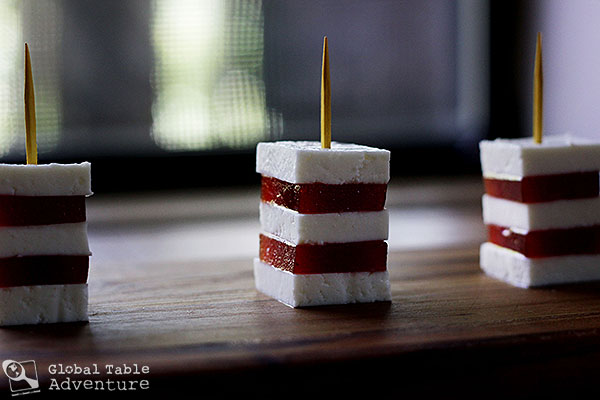
Recipes usually evolve over a long period of time, but today we explore a recipe that one man changed forever. In the late 19th century, José Hernández wrote stories about gauchos, freedom, and love from his home, in Argentina. Gauchos are like the equivalent of the American cowboy: men who’s spirits are forever roaming. His most famous character was Martin Fierro (so famous, in fact, that when the author, Hernández, died, the people announced that Martin Fierro had died, too). Though his stories spoke to the people, he spent much of his life as an exile in Uruguay. As much a creature of habit as any other man, the author became known for ordering the same dessert – one that reminded him of home, but that also celebrated the local ingredients in Uruguay: He always ordered a certain dessert modeled on the popular Argentinian sweet known as Vigilante, which consisted of slices of cheese and sweet-potato paste. The dessert’s curious name derived from the eighteenth- and nineteenth-century policemen who ate cheese with sweet- potato paste because …
Read More


